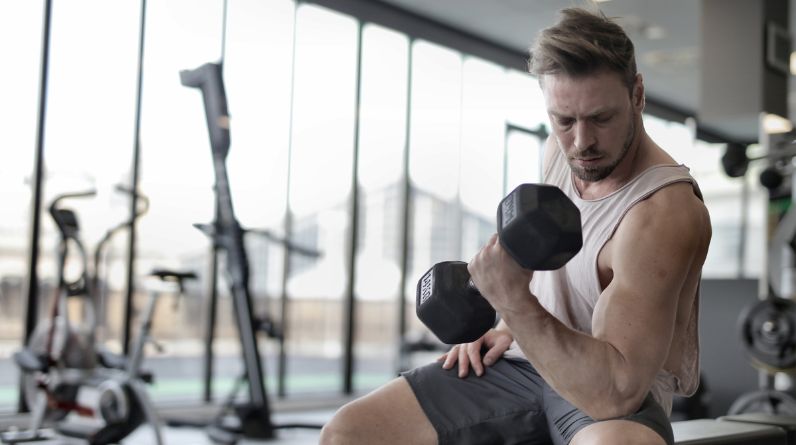High-repetition training (HRT), characterized by using lighter weights for more repetitions (typically 15-25), has long been a mainstay in bodybuilding routines, often employed for hypertrophy (muscle growth) and muscular endurance. However, recent research unveils a nuanced picture of HRT’s impact on muscle health, prompting a closer examination of its advantages and limitations.
Mechanisms of Muscle Hypertrophy
Understanding HRT’s influence requires revisiting muscle growth mechanisms. Muscle fibers adapt to stress through a process called mechanoreception, where mechanical tension stimulates cellular pathways leading to protein synthesis and ultimately hypertrophy. Traditionally, it was believed that heavier weights with lower repetitions (low-repetition training, LRT) generated maximal tension, translating to superior muscle growth.
However, research suggests HRT can also trigger significant hypertrophy [1, 2]. This can be attributed to several factors:
- Metabolic Stress: HRT utilizes lighter weights, allowing for greater training volume (sets and reps) within a workout. This increased volume leads to higher metabolic stress, characterized by the burning sensation experienced during exercise. This stress, mediated by metabolites like lactate, can stimulate muscle growth pathways independent of heavy weights [3].
- Time Under Tension (TUT): HRT inherently extends TUT, as more repetitions take longer to complete. This sustained time under stress can also contribute to muscle growth, although research suggests it likely plays a secondary role compared to metabolic stress [4].
- Fast-Twitch Muscle Fiber Recruitment: While LRT primarily targets fast-twitch fibers (important for power), HRT might also recruit these fibers, particularly at higher intensities approaching failure [5]. Fast-twitch fibers have a greater potential for hypertrophy compared to slow-twitch fibers, contributing to overall muscle growth.
Benefits of HRT for Bodybuilders
Considering these mechanisms, HRT offers several advantages for bodybuilders:
- Increased Muscular Endurance: HRT demonstrably improves muscular endurance, allowing for more training volume within a workout and potentially facilitating longer workouts overall. This can contribute to greater calorie expenditure and further support hypertrophy.
- Reduced Risk of Injury: Lighter weights used in HRT translate to lower joint and tendon stress compared to LRT. This is particularly beneficial for individuals recovering from injuries or prone to joint pain.
- Pump Effect and Blood Flow: HRT promotes a “pump” effect, characterized by an engorgement of muscles due to increased blood flow. This can enhance nutrient delivery to muscle tissue, potentially aiding in recovery and growth.
- Improved Technique and Mind-Muscle Connection: Lighter weights allow for a greater emphasis on proper form and technique, crucial for muscle isolation and targeted growth. This can also enhance the mind-muscle connection, improving the lifter’s ability to consciously contract the desired muscle group.
Limitations of HRT
While HRT offers valuable benefits, it’s crucial to acknowledge its limitations:
- Lower Peak Force Production: Compared to LRT, HRT typically generates lower peak force, potentially limiting the absolute strength gains achievable. For bodybuilders seeking maximal strength, incorporating LRT periods within their training program remains beneficial.
- Diminished Myofibrillar Hypertrophy: HRT primarily promotes sarcoplasmic hypertrophy, the enlargement of fluid and glycogen stores within the muscle cell. While contributing to muscle size, it might offer a less dense and visually impactful appearance compared to myofibrillar hypertrophy, the increase in contractile protein filaments (myofibrils) primarily achieved by LRT [6].
Optimizing HRT for Bodybuilders
To maximize the benefits of HRT while considering its limitations, bodybuilders can implement the following strategies:
- Progressive Overload: Continuously challenge your muscles by gradually increasing training volume (sets, reps, or time under tension) over time.
- Intensity Modulation: While primarily employing lighter weights, periodically incorporate sets closer to failure at higher intensities to stimulate fast-twitch fiber growth.
- Strategic Periodization: Cycle between HRT and LRT phases within your training program. This approach allows you to reap the benefits of both training methods, promoting both hypertrophy and strength gains.
Conclusion
HRT represents a valuable tool in a bodybuilder’s arsenal, offering benefits like improved endurance, reduced injury risk, and enhanced blood flow. However, it’s crucial to recognize its limitations, particularly regarding peak force and myofibrillar hypertrophy. By strategically incorporating HRT, modulating intensity, and implementing periodization, bodybuilders can optimize muscle growth and achieve their physique goals. Remember, consulting a certified personal trainer or coach can help you design a personalized program that considers your individual needs and goals while addressing your specific training preferences.
Frequently Asked Questions
1. Is HRT effective for building muscle mass?
HRT can be very effective for muscle growth, particularly when combined with progressive overload and proper nutrition. It promotes hypertrophy through metabolic stress, time under tension, and potential fast-twitch fiber recruitment, albeit with a greater emphasis on sarcoplasmic hypertrophy compared to low-repetition training.
2. Does HRT offer any advantages over low-repetition training (LRT)?
HRT benefits include increased muscular endurance, reduced risk of injury, improved pump and blood flow, and the ability to focus on proper technique and mind-muscle connection. However, LRT remains crucial for maximizing peak force production and myofibrillar hypertrophy.
3. Can HRT help me lift heavier weights?
While HRT primarily focuses on muscular endurance, it can indirectly contribute to strength gains by improving your nervous system’s ability to recruit muscle fibers. Additionally, incorporating periodic high-intensity sets within HRT can stimulate fast-twitch fibers associated with strength.
4. Is HRT suitable for beginners?
HRT can be a great starting point for beginners due to its focus on proper form and lower stress on joints. However, as they progress, incorporating LRT phases becomes beneficial to build a strong foundation for both muscle size and strength.
5. How many reps should I perform with HRT?
The typical rep range for HRT falls between 15-25, but it can be adjusted based on your goals and experience level. Aim for a challenging but sustainable effort, ensuring proper form throughout every repetition.
6. Should I train to failure with HRT?
While not necessarily a requirement for HRT, training close to failure (leaving 1-2 repetitions in reserve) during some sets can stimulate additional muscle growth, particularly for more experienced individuals.
7. How often should I incorporate HRT into my routine?
The frequency of HRT depends on your overall training program and recovery capacity. It can be used 2-4 times per week, but remember to allow adequate rest for optimal muscle growth and repair.
8. Can I combine HRT with other training methods?
Absolutely! Combining HRT with LRT within a periodization scheme is highly beneficial. This allows you to exploit the advantages of both methods and achieve well-rounded muscle development.
9. What are some considerations when designing an HRT program?
Focus on progressive overload, incorporate intensity variations, and consider periodization. Additionally, consult a certified trainer or coach to create a program tailored to your individual needs and goals.
10. Is HRT safe?
HRT can be safe when performed with proper technique and within your limitations. However, it’s crucial to listen to your body and seek medical guidance if you experience any pain or discomfort during your workouts.




